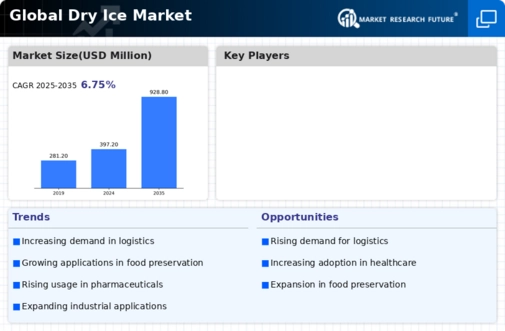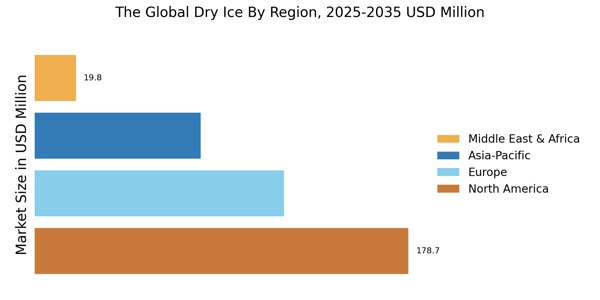Rising Demand in Food Preservation
The increasing emphasis on food safety and preservation is a notable driver for The Global Dry Ice Industry. As consumers become more health-conscious, the demand for fresh and frozen food products rises. Dry ice plays a crucial role in maintaining the quality and safety of perishable goods during transportation and storage. The food and beverage sector is projected to account for a substantial share of the market, with estimates suggesting it could reach approximately 40% of the total dry ice consumption. This trend is likely to continue as more companies adopt dry ice for shipping and storage, ensuring that products remain at optimal temperatures and reducing spoilage rates.
Expansion of the Pharmaceutical Sector
The pharmaceutical industry is experiencing significant growth, which is positively impacting The Global Dry Ice Industry. Dry ice is essential for the transportation of temperature-sensitive medications and vaccines, ensuring their efficacy during transit. With the pharmaceutical market projected to grow at a compound annual growth rate of around 5% over the next few years, the demand for dry ice is expected to rise correspondingly. This growth is driven by the increasing need for advanced healthcare solutions and the expansion of biopharmaceuticals, which often require stringent temperature controls. Consequently, the reliance on dry ice for maintaining the integrity of these products is likely to bolster market growth.
Growth in E-commerce and Online Food Delivery
The rise of e-commerce and online food delivery services is significantly influencing The Global Dry Ice Industry. As more consumers turn to online platforms for grocery shopping and meal delivery, the need for effective temperature control during shipping becomes paramount. Dry ice is increasingly utilized to ensure that perishable items remain fresh during transit, thereby enhancing customer satisfaction. The e-commerce food sector is expected to grow at a rapid pace, with projections indicating a potential increase of over 20% in the coming years. This trend is likely to drive the demand for dry ice, as companies strive to meet consumer expectations for quality and safety in their delivered products.
Increasing Applications in Industrial Processes
The versatility of dry ice in various industrial applications is a key driver for The Global Dry Ice Industry. Industries such as manufacturing, automotive, and electronics utilize dry ice for cleaning, cooling, and as a refrigerant. The adoption of dry ice blasting technology for cleaning machinery and equipment is gaining traction due to its effectiveness and environmental benefits. As industries continue to seek sustainable and efficient solutions, the demand for dry ice is expected to grow. Market analysts suggest that the industrial segment could account for a significant portion of dry ice consumption, potentially reaching 30% of the overall market share in the near future.
Technological Innovations in Dry Ice Production
Technological advancements in the production of dry ice are shaping The Global Dry Ice Industry. Innovations such as improved manufacturing processes and enhanced efficiency in production techniques are making dry ice more accessible and cost-effective. These advancements may lead to a reduction in production costs, which could potentially lower prices for end-users. Furthermore, the introduction of automated systems in dry ice production facilities is likely to increase output and ensure consistent quality. As a result, the market may witness a surge in demand from various sectors, including food, pharmaceuticals, and logistics, as companies seek reliable and efficient solutions for their temperature control needs.


















Leave a Comment